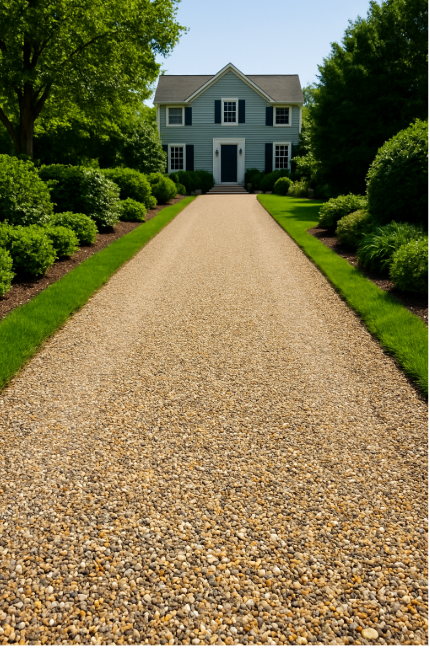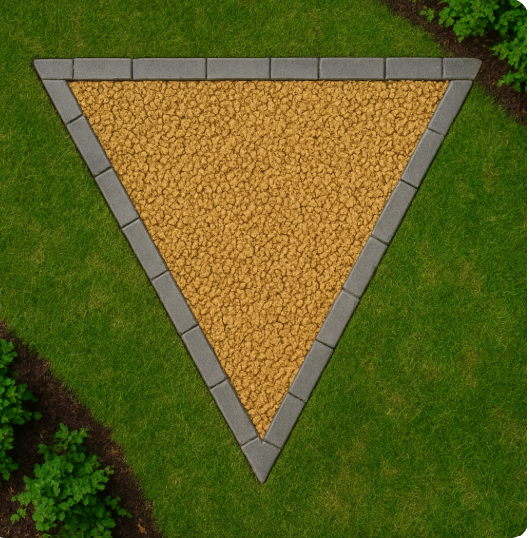Crushed Gravel Calculator
Scroll down to find the shape of your choice
Crushed Gravel Calculator – Straight Path
Width
Calculation is based on average density of 1600 kg/m³.
Calculation Results
Gravel Volume
0.00 m³
Gravel Weight
0.00 t

Crushed Gravel Calculator – Curved Path
Calculation is based on average density of 1600 kg/m³.
Calculation Results
Gravel Volume
0.00 m³
Gravel Weight
0.00 t

Crushed Gravel Calculator for Circular Area
Calculation is based on average density of 1600 kg/m³.
Calculation Results
Gravel Volume
0.00 m³
Gravel Weight
0.00 t

Annular Ring Path Crushed Gravel Calculator
Calculation is based on average density of 1750 kg/m³.
Calculation Results
Gravel Volume
0.00 m³
Gravel Weight
0.00 t


Triangular Crushed Gravel Volume Calculator
Weight is calculated on the average pea gravel density of 1750 kg/m³. You can always enter the density manually for customized calculations.
Calculation Results
Gravel Volume
0.00 m³
Gravel Weight
0.00 t

What Is Crushed Gravel?
Crushed gravel is a type of aggregate created by mechanically breaking down larger stones (usually limestone, granite, or basalt) into smaller, angular fragments. Unlike naturally rounded gravel, which forms through years of erosion and tumbling in rivers or glacial beds, crushed gravel has jagged edges and a rough surface texture. These physical characteristics give it superior locking ability when compacted, making it a preferred material for structural support, stability, and drainage.
Crushed gravel is produced in various sizes, commonly ranging from 3/8 inch to 1½ inches in diameter. The most widely used size for residential and light construction projects is ¾ inch. Finer grades may also include “minus” gravel (e.g., ¾” minus), which contains both crushed stone and stone dust.
On the other hand, “clean” gravel refers to stone that has been washed to remove fines, making it more suitable for drainage applications like French drains or retaining wall backfill.
This material is often used beneath concrete, asphalt, patios, and paver systems because of its excellent load-bearing properties. It also performs well in driveways, pathways, and shed bases, especially where long-term ground stability is important. Crushed gravel's sharp profile helps it stay in place, reducing rutting or spreading over time compared to rounder materials.
How Much Crushed Gravel Do You Need?
Estimating how much crushed gravel you need starts with a basic volume calculation. No matter the shape, the goal is to find out how many cubic meters or cubic feet of material are required to fill the space to a given depth.
The core formula behind all gravel volume estimates is straightforward:
Volume = Area × Depth
Once volume is calculated, you can estimate weight by applying the standard density of crushed gravel. A commonly used value is 1,750 kg/m³ or 109 lb/ft³.
Multiply the volume by this density to determine how much gravel you’ll need in weight
Typical Applications of Crushed Gravel
Crushed gravel is widely used across residential, commercial, and landscaping projects because of its durability, compactability, and versatility. Its angular edges help it interlock and stay in place under pressure, making it ideal for structural bases, walking surfaces, and drainage layers.
Below are the most common applications where crushed gravel is preferred:
Driveways
Crushed gravel is one of the most popular materials for building driveways. It compacts tightly and forms a firm base that supports vehicle traffic while allowing water to drain through.
Walkways and Garden Paths
A layer of fine crushed gravel provides a stable walking surface that resists shifting under foot. It's especially useful for curved or decorative paths due to its ease of shaping and ability to stay in place when edged properly.
Patio Bases
Crushed gravel is used as a foundational layer under pavers, bricks, or stone patios. It distributes weight evenly and improves drainage, which helps prevent surface cracking or shifting over time.
French Drains and Trench Backfill
Clean, washed crushed gravel is ideal for drainage systems. It allows water to flow freely while supporting perforated drain pipes and reducing the risk of clogging.
Shed and Container Foundations
For sheds, small buildings, or shipping containers, crushed gravel provides a cost-effective, level, and moisture-resistant base that supports long-term structural stability.
Retaining Wall Footings
The base of any retaining wall should rest on compacted crushed gravel to improve stability, aid drainage, and prevent wall failure from shifting soil or trapped water.
Fire Pit Surrounds and Outdoor Seating Areas
Crushed gravel can be used around fire pits or in informal seating zones to create a neat, low-maintenance surface that’s easy to install and blends well with natural landscapes.
Parking Pads and Utility Access Areas
Where concrete or asphalt is not required, crushed gravel offers a stable surface for temporary or permanent parking, equipment staging, or emergency vehicle access zones.
Crushed Gravel Depth Guidelines by Project Type
The depth of crushed gravel directly affects how much material you'll need and how well your surface performs over time. A project that’s too shallow may shift or rut, while an overly deep layer wastes material and budget. Below are typical depth recommendations based on industry standards and field-tested applications.
Walkways & Garden Paths
Recommended Depth: 2 to 3 inches (5–8 cm)
Enough for stability and comfort, especially when compacted over a firm base.
Driveways
Recommended Total Depth: 4 to 6 inches (10–15 cm)
Typically installed in two layers: a coarse base followed by a finer top layer.
Heavier vehicles or frequent use may require deeper layering.
Patio Bases (under pavers or flagstones)
Recommended Depth: 4 to 6 inches (10–15 cm)
Supports uniform weight distribution and minimizes surface shifting.
Usually topped with bedding sand or stone dust.
French Drains & Drainage Trenches
Recommended Depth: 12 inches (30 cm) or more
Used to fill the trench around drain pipes, allowing water to pass through freely.
Clean, washed crushed gravel is preferred for this use.
Shed or Container Foundations
Recommended Depth: 4 to 8 inches (10–20 cm)
Compacted gravel provides long-term stability and moisture protection under structures.
Fire Pit Zones or Outdoor Seating Areas
Recommended Depth: 3 to 4 inches (7–10 cm)
Creates a clean, weed-resistant, and low-maintenance surface for gathering spaces.
Retaining Wall Base
Recommended Depth: 6 inches (15 cm) minimum
Compacted crushed gravel ensures a strong, well-drained foundation for the first course of wall blocks.
Parking Pads or RV Access Areas
Recommended Depth: 6 to 8 inches (15–20 cm)
Suitable for supporting parked vehicles and resisting rutting under heavy loads.
Where Not to Use Crushed Gravel
While crushed gravel is durable and versatile, it isn’t suitable for every environment. Using it in the wrong context can lead to discomfort, drainage issues, maintenance headaches, or even safety risks. Below are common situations where crushed gravel should be avoided — along with better alternatives.
Aquariums and Fish Tanks
Crushed gravel often contains limestone or other reactive minerals that can alter water chemistry. Its sharp edges may also injure fish, especially bottom dwellers.
Better option: Smooth, inert aquarium gravel or silica-based substrates.
Children’s Play Areas
The angular surface of crushed gravel is too harsh for falls and rough on bare feet. It also poses a tripping hazard for younger children.
Better option: Rounded pea gravel, engineered wood fiber, or rubber mulch.
Indoor Flooring or Covered Living Spaces
Crushed gravel is not designed for interior use. It cannot be compacted to a fully smooth surface, and the rough particles can damage floors or equipment.
Better option: Concrete, wood, tiles, or pavers depending on the space.
Lawn or Grass Areas
Gravel creates a permanent barrier that prevents root growth and holds heat in the soil. It’s also difficult to remove once installed.
Better option: Loam-based topsoil and turf or native groundcover.
Decorative Patio Surfaces (Top Layer)
While excellent as a base, crushed gravel is generally too rough and unstable for exposed surfaces where people walk or place furniture. It can shift easily and feel uneven underfoot.
Better option: Pea gravel, decomposed granite, or paving stones.
Steep Slopes Without Retention
On sloped ground, crushed gravel tends to migrate downhill during rain or heavy use unless it's stabilized with edging, grids, or retaining features.
Better option: Geogrid-stabilized gravel or erosion-control matting with turf.
Frequently Asked Questions (FAQs)
How many tons are in 1 cubic yard of crushed gravel?
One cubic yard of crushed gravel weighs approximately 1.3 to 1.5 tons, depending on compaction and moisture. A safe average for estimating is 1.4 tons per cubic yard when using standard density.
How deep should crushed gravel be for a driveway?
For most residential driveways, a depth of 4 to 6 inches (10 to 15 cm) is recommended. Heavier vehicles or frequent use may require up to 8 inches. Always compact in layers to avoid settling.
Can I use crushed gravel under pavers?
Yes, crushed gravel is the preferred sub-base material for paver installations. It provides a stable, well-draining foundation. Use ¾" crushed gravel for best results, followed by a layer of bedding sand or stone dust.
Is crushed gravel good for drainage?
Crushed gravel performs well in drainage systems, especially when clean and free of fine particles. It’s commonly used in French drains, around retaining walls, and as trench backfill to allow water to flow freely.
What is the difference between crushed gravel and pea gravel?
Crushed gravel is angular and locks together when compacted, making it suitable for structural and load-bearing applications. Pea gravel is smooth and rounded, better suited for decorative or low-traffic areas. Crushed gravel is also more stable on slopes or driveways.
How do I calculate how much crushed gravel I need?
Use the formula: Volume = Length × Width × Depth, then multiply the result by the gravel’s density (usually 1,750 kg/m³ or 109 lb/ft³) to estimate weight. You can also use the calculators above for automatic results based on your project shape.
Can crushed gravel be used as a finished surface?
It can, but it’s not ideal for high-traffic or decorative areas. The angular edges can be rough underfoot and prone to shifting unless stabilized. For a cleaner, more comfortable finish, consider topping it with finer material or using pavers.